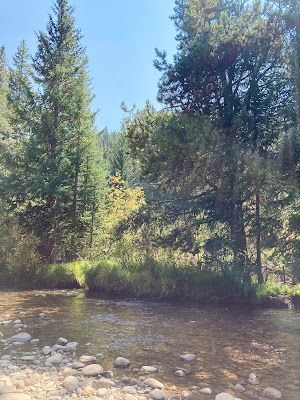The river resonates trickles, bubbles, and ripples with the existence of what a river is. The river is the promise land to the fly angler for catching stunning trout. It is a real priority to take the time to read the river to make a day on the river a success before the first cast. Taking the time to read the water is a divine tool to help determine the most likely places where fish are gathering.
Stand and observe a fair distance from the river to read the river. Take a deep breath, sip on your coffee, and study the surroundings. Observe the bugs flittering in the air, what is crawling on you, or hopping and landing on your wader boots. Don’t be that guy clomping right into the fish pot and running down all the fish. Cool your jets of excitement and transition into what the river has to offer. Here are some sections on the river to look for on your next visit.
 |
| Listen to the riffle. |
Seek the riffles, or shallow section of the river where water cascades over rocks creating a surface disturbance. Riffles are choppy at the surface riding over rocks in the water. These shallow riffles are highly oxygenated for the trout, and it can be a fantastic habitat for aquatic insects to fancy the fish to eat. The deeper riffles with rocks and boulders offer fish rest and a spot to hunker down away from predators. Where riffles drop off into a deeper section of water gives the fish a lagging current and many great offerings of insects that are sweeping over the edge.
 |
| A fishy run. |
Runs are an area directly below from the riffles and where the water current become more uniform and deeper. Runs are an excellent location to look for trout in a river or stream. Fish seek shelter in the deeper water as well as the near vicinity for a feast. Fish often suspend at the edge of the current or drift along the bottom eating bugs that are surrendered downstream below the riffle.
 |
| The foamy bubbly trails identify a seam. |
A seam is any region where two adjacent water currents converge where one is slower then the other. This could be an obstruction such as a log, a boulder, or an extension of the shore which causes a distinct disruption from the main current flow. Trout fancy the seams and foamy bubble trails as they create feeding lanes that collect and deliver food.
 |
| Pools are great for beginners to learn how to fly fish. |
A pool is the deepest segment of a river with a leisure moving current. I like to call these sections, fish pots. Fish will often advance to a pot on brilliant, sunny day, or if they sense danger. Quite often, the big fish typically may spend a good portion of their day in these pools where they are less active. Approach quietly and a little distance from the river banks before the cast. Fish near to far.
 |
| An eddy disrupting the river flow. |
An eddy is a point of where structures or an depression of the riverbank such as a sizable boulder, a log, or a fallen tree disturbs the river current and direction flow. Directly downstream of the object, a pocket of swirling water will form opposite the main direction of current flow. Fish are fond of eddies because they entrap and channel concentrated food sources drifting by in the current. Look for foam or bubbles collecting on the surface of the water where the main current meets up with the swirling water and place your casts there.
 |
| The tailout is the calm water above before the action of the riffle. |
A tailout is a shallow, even section at the end of a pool before the water descents down into another riffle. A natural funnel is formed which carries anything drifting downstream directly to the fish. Fish will often reprieve in a tailout and sip on hatching insects off the surface as they float by. Look for rising fish and get your dry fly on for your cast. If the fish are not rising, be very stealth with your approach and quietly cast your nymphs.
Below the water surface, search for changes in the river such as shelves, gravel beds, bends, and contours of the river bottom. Fish will often be slumbering and feeding on the deeper side of these areas. Fish frequently rest in the poky current below the drop-off from a riffle gorging on insects that come over the brim.
 |
| Fish those shallow waters! |
Don’t overlook the shallows. We may think we can spot trout particularly when the sun is at its highest point in the day. You maybe pleasantly surprised with casting into the shallows, a surprising take. I have caught lots of fish in the shallows particularly with dry fly on smaller creeks. Many of these shallow sections hold cups, shelves, and unseen structure that can provided the perfect camouflage cover for the aggressive trout.
Consider the time of day in your planning with morning and evenings. These times of the day generally are the best times to fish in the day. Conditions are typically cooler, shadows are elongated, and the insect hatches are usually of greater prevalence.
Before making the first cast, take the time to read the river. Select a section of the river and which structure to target. Experience is the key to success. Taking the time to understand the bubbles, plash, and the segments of the river can lead you to a very prosperous day of catching many fish. See you on the river!
This blog is featured on Togens Fly Shop, Reading the River












































